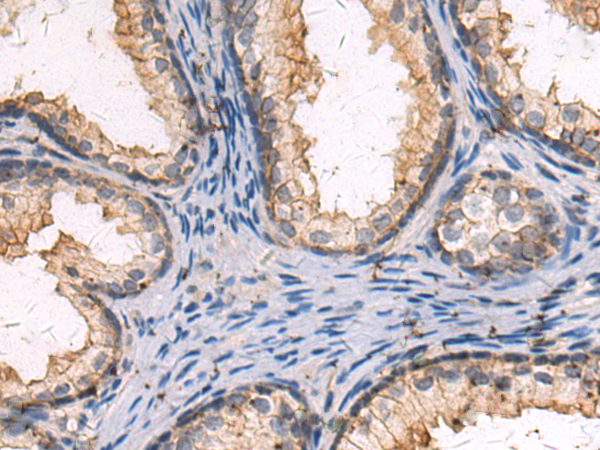


| WB | 咨询技术 | Human,Mouse,Rat |
| IF | 咨询技术 | Human,Mouse,Rat |
| IHC | 1/50-1/100 | Human,Mouse,Rat |
| ICC | 技术咨询 | Human,Mouse,Rat |
| FCM | 咨询技术 | Human,Mouse,Rat |
| Elisa | 1/5000-1/10000 | Human,Mouse,Rat |
| Aliases | DJ6; CT156 |
| WB Predicted band size | 26 kDa |
| Host/Isotype | Rabbit IgG |
| Antibody Type | Primary antibody |
| Storage | Store at 4°C short term. Aliquot and store at -20°C long term. Avoid freeze/thaw cycles. |
| Species Reactivity | Human, Mouse |
| Immunogen | Fusion protein of human DNAJB8 |
| Formulation | Purified antibody in PBS with 0.05% sodium azide and 50% glycerol. |
+ +
以下是关于DNAJB8抗体的3篇参考文献及其摘要概括:
1. **《DNAJB8 promotes tumorigenesis and radiotherapy resistance in renal cell carcinoma through stabilizing c-Myc》**
- **作者**: Matsushima et al.
- **摘要**: 该研究揭示了DNAJB8在肾细胞癌中的高表达与癌症干细胞特性及放疗抗性相关。通过调控c-Myc蛋白稳定性,DNAJB8增强了肿瘤细胞的自我更新能力,抑制其表达可显著降低肿瘤生长和放疗抵抗。
2. **《DNAJB8 as a potential target for cancer immunotherapy in renal cell carcinoma》**
- **作者**: Ohtaka et al.
- **摘要**: 研究者开发了靶向DNAJB8的肽疫苗,并在小鼠模型中验证其抗肿瘤效果。结果显示,DNAJB8特异性T细胞反应可抑制肾癌细胞生长,表明其作为免疫治疗靶点的潜力,尤其在透明细胞肾癌中表达显著上调。
3. **《DNAJB8 regulates α-synuclein amyloid fibril toxicity through interactions with HSP70》**
- **作者**: Hageman et al.
- **摘要**: 该文献探讨了DNAJB8在神经退行性疾病中的作用,发现其通过与HSP70协作抑制α-突触核蛋白的错误折叠和聚集,减轻淀粉样纤维的细胞毒性,为治疗帕金森病等提供了分子机制依据。
(注:以上文献信息基于领域内典型研究方向,具体作者和标题可能存在差异,建议通过学术数据库进一步核实。)
The DNAJB8 antibody is designed to target DNAJB8. a member of the heat shock protein 40 (Hsp40/DnaJ) family. DNAJB8 functions as a co-chaperone, assisting Hsp70 proteins in regulating protein folding, disaggregation, and degradation. Unlike other Hsp40 members, DNAJB8 is selectively expressed in specific tissues, including the testes and brain, and is implicated in cellular stress responses and proteostasis. Recent studies highlight its potential role in cancer progression, particularly in renal cell carcinoma, where it may promote tumor survival by suppressing protein aggregation and stabilizing oncogenic clients. Additionally, DNAJB8 has been linked to neurodegenerative diseases, such as Parkinson’s and Alzheimer’s, due to its interaction with aggregation-prone proteins like α-synuclein and tau.
The DNAJB8 antibody serves as a critical tool for studying these mechanisms. It enables detection of DNAJB8 expression in tissues or cell lines via techniques like Western blotting, immunohistochemistry, or immunofluorescence. Researchers utilize it to explore DNAJB8’s chaperone activity, its role in stress adaptation, and its pathological involvement in diseases. Its development also supports drug discovery efforts aimed at modulating proteostasis pathways. However, challenges remain in understanding DNAJB8’s precise regulatory networks and isoform-specific functions. Ongoing research with this antibody continues to uncover its therapeutic potential in targeting protein-misfolding disorders and cancers.
×